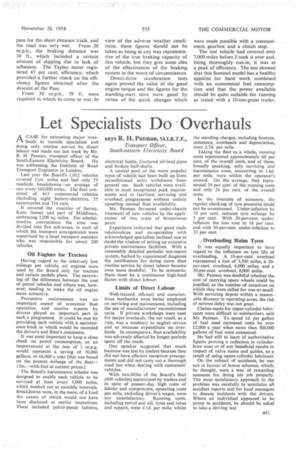Let Specialists Do Overhauls
Page 45

If you've noticed an error in this article please click here to report it so we can fix it.
says R. H. Patman,
Transport Officer, South-eastern Electricity Board rtA CASE for entrusting major overhauls to outside specialists and doing only routine service by direct labour was made out last week by Mr. R. FL. Patman, transport officer of the
South-Eastern Electricity Board. He was addressing the Institute of Road Transport Engineers in London.
Last year the Board's 1,012 vehicles covered I 1 rn. miles and had only 75 roadside breakdowns—an average of one every 160,000 miles. The fleet consisted of 643 commercial vehicles (including eight battery-electrics), 55 motorcycles and 314 cars.
It covered the counties of Surrey, Kent, Sussex and part of Middlesex, embracing 3,200 sq. miles. For administrative convenience the area was divi'ded into five sub-areas, in each of which the transport arrangements were supervised by a local transport assistant who was responsible for about 200 vehicles.
Oil Engines for Tractors
Having regard to the relatively low mileage per vehicle, oil engines were used by the Board only for tractors and certain mobile plant. The narrowing of the difference between the cost of petrol vehicles and others was, however, tending to make the oil engine more attractive.
Preventive maintenance was an important aspect of economic fleet operation, and routine reports by drivers played an important part in such a programme. It could be met by providing each vehicle with a maintenance book in which would be recorded the driver's and fitter's comments.
It was most important to keep a close check on petrol consumption, as an improvement at the rate of 1 m.p.g. would represent a saving of 30,000 gallons, or £6,000 a year [this was based on the present mileage of the fleet13m.—with fuel at current prices.] The Board's maintenance scheme was designed to enable each vehicle to be serviced at least every 1,000 miles, which worked out at monthly intervals. Breakdowns were, in the main, of a kind the causes of which would not have been disclosed at earlier inspections. These included petrol-pump failures, electrical faults, fractured oil-feed pipes and broken half-shafts.
A. central pool of the more popular types of vehicle had been built up from reconditioned units withdrawn from general use. Such vehicles were available to meet exceptional peak requirements and to facilitate servicing and overhaul programmes without unduly upsetting normal fleet availability.
Mr. Patman favoured under-chassis treatment of new vehicles by the application of two coats of bituminous paint, Experience indicated that good trade relationships and co-operation with acknowledged specialists inclined one to doubt the wisdom of, setting up extensiVe private maintenance facilities. With a reasonably detailed periodic test-report system, backed by experienced diagnosis the justification for doing more than routine service by direct labour became even more doubtful. To be economic, there must be a continuous high-load factor with direct labour,
Limits of Direct Labour
Well-trained, efficient and conscientious mechanics were better employed on servicing and maintenance, including the use of manufacturers' reconditioned units. If private workshops were used for major overhauls, the net result, as a rule, was a tendency to neglect service and so increase expenditure on overhauls. In consequence, fleet availability was adversely affected by longer periods spent off the roads.
One speaker suggested that much business was lost by traders because they did not have efficient reception arrangements and did not carry out a thorough road test when dealing with customers' vehicles, With two-fifths of the Board's fleet (400 vehicles) maintained by traders-and in spite of present-day high costs of labour and components, operating costs per mile, excluding driver's wages, were not unsatisfactory. Running costs, including petrol and oil, tyres and tubes and repairs, were 4.1d. per mile, whilst the standing charges, including licences, insurance, overheads and depreciation, were 2.7d. per mile.
Taking the fleet as a whole, running costs represented approximately 60 per cent. of the overall costs, and of these, broadly speaking, only servicing and maintenance costs, amounting to 1.6d. per mile, were within the operator's control. On the average, they represented 39 per cent. of the running costs and only 24 Per cent. of the overall costs.
In the interests of economy, the regular checking of tyre pressures could not be overstressed. Under-inflation by 10 per cent, reduced tyre mileage by 5 per cent. With 20-per-cent. underinflation the loss rose to 16 per cent. and with 30-per-cent. under-inflation to 33 per cent. .
Overloading Ruins Tyres
It was equally important to have regard to the influence on tyre life of overloading. A 10-per-cent. overload represented a loss of 3,500 miles, a 20per-cent. overload, 6,000 miles, and a 30-per-cent overload, 8,000 miles.
Mr. Patman was doubtful whether the cost of carrying spare wheels could be justified, as the number of occasions on which they were called for was so small. With servicing depots within a reasonable distance in operating areas, the risk of serious delay was not great.
Claims made for upper-cylinder lubricants were difficult to substantiate% said Mr. Patman. To spend Id. per gallon of fuel used increased costs by over £2,000 a year when more than 500,000 gallons of fuel were consumed.
He had still to learn of authoritative figures proving a reduction in cylinderbore wear or of any beneficial results in respect of valve stems and guide's, as a result of using upper-cylinder lubricant.
On the subject of accidents, he was not in favour of bonus schemes, which, he thought, were a way of rewarding someone for doing his job properly. The most satisfactory approach to the problem was carefully to scrutinize all accident reports and for local managers to discuss incidents with the drivers. Where an individual appeared to be prone to accidents, he should be asked to take a driving test.




























































































